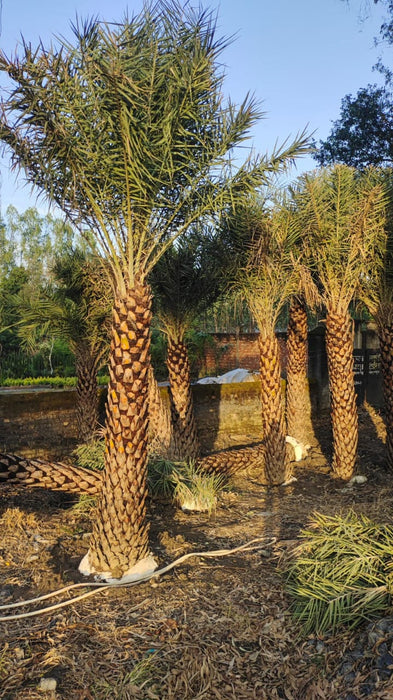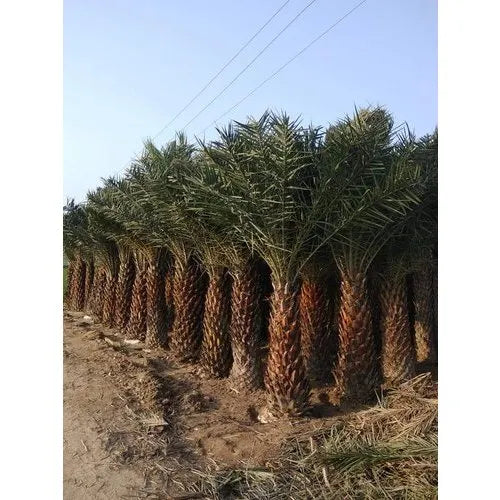
Date Palm - Phoenix dactylifera
Scientific Name and General Information
The Date Palm (Phoenix dactylifera), a prominent member of the palm family (Arecaceae), is a highly valued tree cultivated for its sweet, nutritious fruit—dates. It has a rich history, believed to have been cultivated as early as 4000 BCE in the Mesopotamian region, now modern-day Iraq. Over centuries, the Date Palm became a staple crop in arid regions of North Africa, the Middle East, and beyond, symbolizing sustenance and prosperity.
The tree’s resilience in harsh, arid climates, coupled with its utility in providing food, shelter, and materials, has made it a cornerstone of desert agriculture. Today, it is extensively grown in countries such as Egypt, Iran, Saudi Arabia, Iraq, and regions like California and Mexico.
Physical Description
The Date Palm can reach heights of up to 23 meters (75 feet), crowned with feathery, arching fronds that lend an iconic appearance. The trunk is sturdy and ridged, marked by scars from fallen leaf bases. A mature Date Palm typically features 100-120 pinnate leaves, each spanning up to 5 meters (16 feet).
The tree produces small, inconspicuous flowers on separate male and female trees. Farmers often employ manual pollination to ensure optimal fruit production. The fruit, a drupe, is oblong and varies in size, color, and sweetness depending on the cultivar. A single cluster can weigh up to 8 kilograms (18 pounds) and hold over a thousand dates.
Cultivation and Growth
Date Palms thrive in sandy, well-drained soils and require a hot, dry climate for optimal growth. They are remarkably drought-tolerant but depend on a consistent water supply to achieve high fruit yields.
Propagation is done through seeds or offshoots. Offshoots, or suckers, emerge at the base of young palms and are commonly used for commercial cultivation. These are separated and planted once they develop a robust root system, usually at 3-6 years of age.
Date Palms begin fruiting within 4-6 years and reach peak production between 10 and 15 years. A single tree can produce 40–80 kilograms (90–180 pounds) of dates annually, with some varieties yielding even more. While the tree can live for over a century, its commercial productivity declines after several decades, leading to periodic replanting in plantations.
Uses
The Date Palm is a multi-purpose tree, with almost every part offering economic or cultural value:
1 Fruit: Dates are rich in sugars, fiber, and essential nutrients. Fresh dates are soft and sweet, while dried varieties are used in confectionery, syrups, and beverages.
Wood and Leaves: The trunk provides durable wood for construction and crafts, while the leaves are used to make baskets, mats, and thatching material.
Byproducts: Date seeds are ground into animal feed or processed for oil extraction. Other byproducts include ethanol, vinegar, and natural sweeteners.
Cultural Significance: Date Palms hold religious and cultural importance in many regions. Their leaves are used in Christian Palm Sunday celebrations, while dates are a symbolic food during Islamic fasting rituals, especially Ramadan.
Economic Importance
The Date Palm plays a critical role in the economies of arid and semi-arid regions. Major producers like Egypt, Iran, Saudi Arabia, and Iraq dominate the global market, while countries like Algeria and Tunisia are renowned for exporting premium-quality dates, particularly to Europe. In the Americas, California has established itself as a leading producer of dates, including popular varieties like Deglet Noor and Medjool.
Environmental Benefits
Beyond their economic value, Date Palms contribute significantly to environmental conservation. Their deep roots stabilize soil, preventing erosion, while their dense foliage provides shade and reduces local temperatures, making them an asset in combating desertification.
Conclusion
The Date Palm is not just a tree; it is a legacy of human ingenuity and nature's resilience. Its sweet fruit, iconic silhouette, and versatility make it indispensable in the regions where it grows. From nourishing communities to enhancing landscapes, the Date Palm continues to stand tall as a symbol of sustenance, beauty, and enduring utility.

